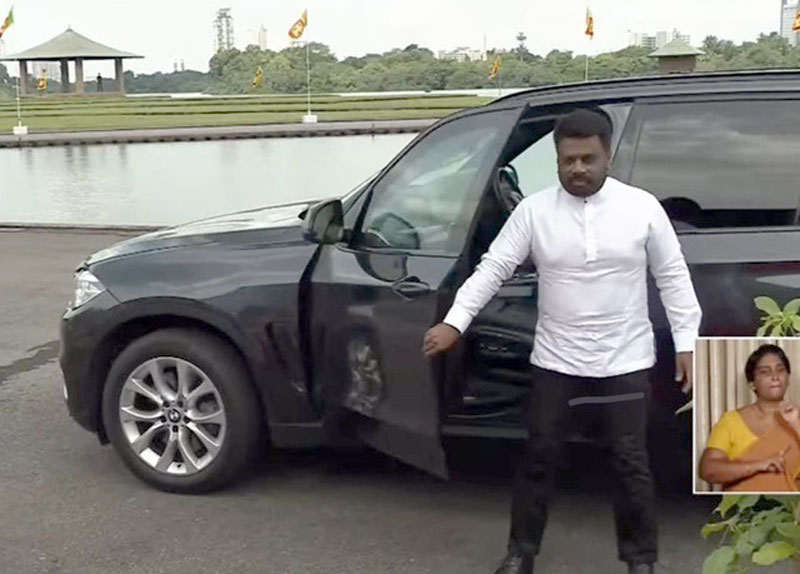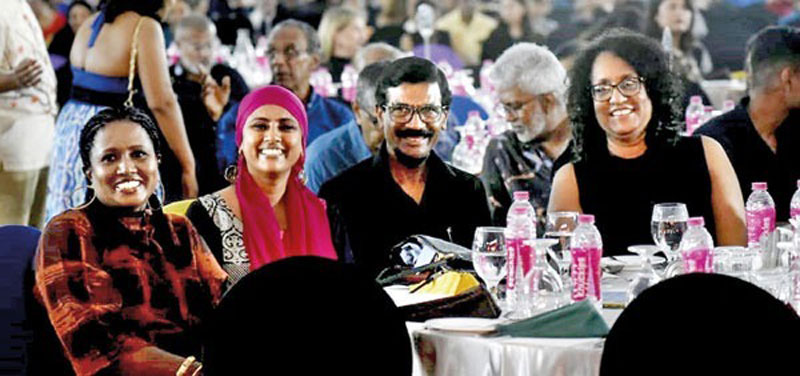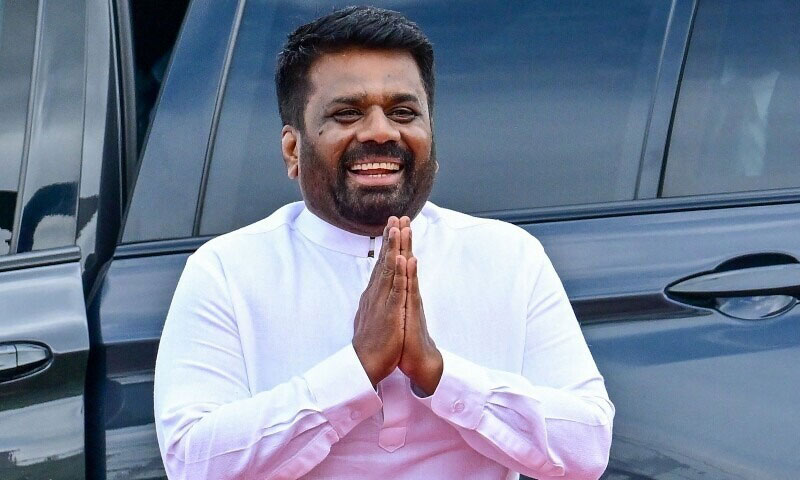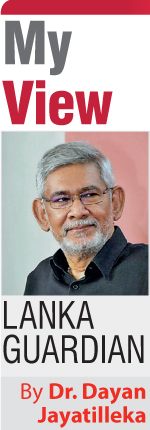Thursday Nov 28, 2024
Thursday Nov 28, 2024
Thursday, 28 November 2024 00:45 - - {{hitsCtrl.values.hits}}

Presidential self-reliance

Party hardliner Tilvin at soft-pop ABBA party

New Presidential style
 The most memorable visual image of Sri Lanka’s new Parliamentary session, the first to be opened by newly-elected leftwing President Anura Kumara Dissanayake, was also the moment that best symbolized the primarily progressive character or aspect of his presidency and the JVP-NPP victory. It is when he opened his car door unaided, stepped out of it in the same outfit he wore as an MP, and beamed. That, and dispensing with religio-cultural rituals that always precede or accompany such occasions here, though not in any legislature of a Republic anywhere else, extended the promise of the first fully modern Sri Lanka presidency and administration.
The most memorable visual image of Sri Lanka’s new Parliamentary session, the first to be opened by newly-elected leftwing President Anura Kumara Dissanayake, was also the moment that best symbolized the primarily progressive character or aspect of his presidency and the JVP-NPP victory. It is when he opened his car door unaided, stepped out of it in the same outfit he wore as an MP, and beamed. That, and dispensing with religio-cultural rituals that always precede or accompany such occasions here, though not in any legislature of a Republic anywhere else, extended the promise of the first fully modern Sri Lanka presidency and administration.
The Political Establishment is gone, the Economic Establishment remains. The political elite is peacefully overthrown, the economic elite is more entrenched and expansive than before. A ‘bourgeois-democratic’ political revolution sweeping away an ancien regime, a decrepit political overhang, is necessary for the economic establishment to unleash growth which can take us out of the debt crisis.
There is a problem, though.
It is not that AKD isn’t “exiting the IMF deal” as his FSP/PSA critics demand, but that he is supinely compliant, sticking to its letter rather than striving for wiggle-room.
Worse, he has chosen Citibank as intermediary with the private international creditors –that’s an almost incestuous relationship-- without tapping as negotiators, experts known to be sympathetic to Sri Lanka’s predicament such as Nobel Prize winner Joe Stiglitz or Argentina’s former Finance Minister Prof Martin Guzman.
Political sociology
The JVP-NPP ‘revolution’ is primarily a generational revolution, which has become a political revolution and (hopefully) a cultural revolution.
The average age of the NPP Ministers, Deputy Ministers and parliamentary group—as indeed that of the whole parliament—seems to represent a demographic displacement of the old political elite.
With some exceptions, this is a postwar generation led by those transitional to that generation. They can look at the nation’s problems with fresh eyes.
A revolution of rationality and modernity is long overdue. When Prof Howard Wriggins reviewed Prof Marshall Singer’s book on Ceylon’s ‘Emerging Elite’ of 1956 in the Journal of Asian Studies (1965) he identified the main contradiction haunting that new elite leading the nation. Closer to the cities than their voters, but closer to the villages than Colombo, they wanted a modern, industrialized nation but felt compelled to invoke the traditionalism of the social milieu from which they had come and been voted-in.
The “Children of ‘56” (Mervyn de Silva, 1972) the JVP-NPP, have at long last resolved that contradiction. They were able to because of the matrix from which generations of them had emerged: the vast system of Sri Lanka’s state universities. That gives them a mindset, manner and motivation very different from, on the one hand, the SJB’s drunken dancers (with ambassadors, even) of the Royal-Thomian Mustangs tent, educated in the West even at undergraduate level, and on the other hand, the Sinhala traditionalist (‘Jathika Chinthanaya’) cultural ultranationalists.
Graduation from a Sri Lankan state university is a virtue which our finest, most sophisticated foreign minister Lakshman Kadirgamar celebrated with his famously proud assertion when his portrait was unveiled at Balliol College, Oxford that “the cake was baked at home”. By the Kadirgamar criterion, the SJB’s ideological/policy-making elite is ‘half-baked’.
Emerging from the state university matrix with its leftist ethos also gives the JVP-NPP a mindset different from the majoritarian Sinhala-Buddhist chauvinism of a minority of students who suffered culture-shock from the encounter with modernity and rationality, and sought refuge in Sinhala-Buddhist ideology as a counter to the leftism and relative modernity that preponderated on the campuses.
Dilith Jayaweera with his uncultured ‘sociocultural’ critique of Prime Minister Harini Amarasuriya is a contemporary example, but the great 1960s novel by Siri Gunasinghe, Hevanalla (The Shadow) translated into English by his wife, sets out the modernist-progressive vs. traditionalist-obscurantist clash of civilizations--and crucially, psychologies and behaviors-- on campuses already in 1950, epitomized by two antipodal characters (Wijepala and Jinadasa) who were friends from very similar social backgrounds. (https://www.colombotelegraph.com/index.php/jinadasa-wijepala-progressive-change-sri-lankan-social-consciousness/)
Socialism, Communism, Marxism-Leninism albeit ‘with Sinhala characteristics’ or ‘Lankan exceptionalist’ deviations, with much of the animating spirit and ethics ‘lost in translation’, was the passage to international politics and history, universalist theories, rationality and modernity, for generations of students from rural/provincial backgrounds. This puts them way ahead of Sinhala ultranationalists as potential agency of long-delayed rationalization and modernization of Sri Lanka. Modernity is possible only with rationality.
The pre-eminence of leftism on the campuses is entirely understandable: copious US polling data shows a clear correlation between college education and leftist orientation. Indeed, the higher the educational qualification, the greater the leftist-orientation.
Patali Champika Ranawaka was in the ballpark, homing-in on the Free Education generations. But he and his ex-acolyte Dilith didn’t/don’t get that even for professionals with a hard science, medicine or management background, there is no appetite for, still less identification with, rightwing ideologies. Their education and international experience, and crucially, the need to communicate with their teenage or young adult children, make them recoil from Gunadasa Amarasekara, Nalin de Silva and now Dilith Jayaweera’s ‘Jathika Chinthanaya’.
Playing Modi doesn’t work here unless disguised as Nehru. The island’s value-system and ethos tend to be skewed left. Which is why on his 91st birthday Ronnie de Mel told Sajith Premadasa and Harsha de Silva that in order to revive the Open Economy they “must infuse it with a strong dose of socialistic values”, because that “underlay the social doctrine of all four major religions on the island”. In their ineffable ignorance, the Blueprint Boys thought they knew better.
With the convergence of three factors, the ‘New Class’, congealed and crystalized, was ready to assume power:
a)Generations of products of Sri Lankan state universities with postgraduate degrees from overseas, returning to the national universities and entering the state sector and professions (e.g. medicine).
b)A substratum with university and professional placements and achievements in the West.
c)An axis between the two enabled by Anura Dissanayake’s persona, discourse and NPP makeover.
Meanwhile the Political Establishment was committing social suicide. The SLPP was the strong successor of a centre-left moderate-nationalist tradition founded by SWRD Bandaranaike and DA Rajapaksa (Mahinda’s father) which was primarily based on the rural areas and the peasantry. Gotabaya Rajapaksa’s insane fertilizer policy wrecked the SLPP’s base which had been built up in the South by DM and DA Rajapaksa even before the SLFP was born.
Why didn’t the peasantry, leaving the SLPP under the Gotabaya presidency, shift back to the SLFP? Because the SLFP had already lost that base, allying itself with Ranil Wickremesinghe in the Yahapalana years.
Why did it not shift to the main Opposition SJB, which saw itself in 2020 as the SLFP of 1951? As the September 2024 Presidential election showed, Sajith Premadasa broke into Medawachchiya and Harispattuwa which demonstrated his potential (unlike Harsha de Silva, who preached about Walmart to peasant audiences) to win the rural vote, but it was far too little, far too late.
This was the picture:
 The UNP, SLFP, SLPP, SJB lost their social bases by criminal policy follies.
The UNP, SLFP, SLPP, SJB lost their social bases by criminal policy follies.
 The JVP-NPP’s support among the peasantry and lower-middle classes mushroomed because of the social identification that “these young people from our universities can understand our pain because they come from among us. They are our last hope, when everyone else who was in Government have bankrupted us.”
The JVP-NPP’s support among the peasantry and lower-middle classes mushroomed because of the social identification that “these young people from our universities can understand our pain because they come from among us. They are our last hope, when everyone else who was in Government have bankrupted us.”
 The urban upper/upper-middle classes deserted the political establishment, because it couldn’t deliver the vote of the masses and keep the socioeconomic elite safe, and because they felt safe enough to vote for the NPP as positioned by Anura.
The urban upper/upper-middle classes deserted the political establishment, because it couldn’t deliver the vote of the masses and keep the socioeconomic elite safe, and because they felt safe enough to vote for the NPP as positioned by Anura.
To re-state:
1.Where Anura and the JVP-NPP were coming from socially, brought in mass support at a time of acute economic crisis. Where they were at socially and ideologically, brought in the economic elite. Coming from the ‘grassroots’—AKD’s father was an agrarian worker-- they had become a ‘gentrified’ emergent elite.
2. Anura’s re-positioning of the JVP and launch of the NPP helped de-link the economic elite from the Establishment parties.
3. The UNP, SLFP, SLPP, SJB were “stranded out of the crease”, having neither the masses nor the business/managerial elites.
The national university ‘old boy network’ of AKD and the JVP-NPP outweighed and outplayed the ‘old boy networks’ and ‘old school ties’ of the UNP-SJB (Royal-Thomian) and SLFP-SLPP (Anandian) elites. In the Aragalaya-austerity vortex, that social stratum with its ramified networks evolved into a social force.
The generational shift proved vital. It took the ascendancy of the Anura-Bimal-Vijitha-Nalinda ‘age-cohort’ (including Harini, who didn’t study but taught at a state university) to be capable of a new discourse and ‘look’.
Anura and his generation apprenticed as allies of Chandrika Bandaranaike Kumaratunga, Mahinda Rajapaksa, and Maithripala Sirisena-Ranil Wickremesinghe, learning from the inside about the Lankan State which their ‘elder brothers’ had twice tried to overthrow from the outside with catastrophic results.
Cumulatively, these factors enabled AKD and comrades to form a bloc of state university-educated civil servants, professionals, teachers, lawyers, scientists, intellectuals and artists, just as SWRD Bandaranaike assembled his ‘Pancha Maha Balavegaya’ (‘Five Great Forces’).
Hartal 1953 opened the gap for SWRD/SLFP-MEP 1956. Aragalaya 2022 did so for AKD/JVP-NPP 2024.
Ignoring Ronnie de Mel’s advice and Ranasinghe Premadasa’s example, flaunting a technocratic Blueprint (‘3.0’, mind) instead, the SJB failed to capture the all-important ‘Public Imagination’. (https://www.amazon.co.za/Public-Imagination-Political-Ethical-Imperative/dp/0367360616)
Prequel
I predicted the AKD-NPP win a year back, in November 2023, in this column. (https://www.ft.lk/columns/The-last-endgame-AKD-NPP-positioned-to-win-but-should-beware/4-755751)
A decade ago, I was criticized for promoting Anura Kumara Dissanayake as Presidential candidate with potential for national leadership. The critique dated May 2014 published in the widest-known international Trotskyist website was entitled ‘Sri Lankan ex-radical calls for a JVP presidential candidate’. Extracts follow:
‘Dayan Jayatilleka, a former middle-class radical turned diplomat and political adviser to the Sri Lankan establishment, has proposed that Anura Kumara Dissanayake, the new leader of the Janatha Vimukthi Peramuna (JVP), should be the main opposition candidate in the next presidential election…
In an article published last month, entitled “Elections 2015: The Stakes,” Jayatilleka… examines possible opposition candidates, but his conclusion is striking. “What is needed to prevent catastrophe is a Hassan Rouhani-type candidacy: a moderate patriot/nationalist i.e. liberal or progressive Sinhala Buddhist.”
…Casting around for a Sri Lankan Rouhani to galvanise the opposition, Jayatilleka anoints the JVP leader. “The country would be better served by rallying round an out-of-the box presidential candidacy from the Left Opposition: Anura Kumara Dissanayake…” he declares.
“…The resultant return of rationality and realism will resolve the crisis in Sri Lanka’s relations with its neighbours and the world.”
The turn to the JVP is highly significant…Like Jayatilleka, the JVP has long since integrated itself into the political establishment and has cordial relations with the US embassy in Colombo. In 2004, the JVP joined the coalition government of Rajapakse’s Sri Lanka Freedom Party predecessor, Chandrika Kumaratunga, held three ministerial powers and supported pro-market restructuring.
…The JVP announced “a new policy framework” in February 2014, entitled “Our Vision.” Behind its phrase-mongering about “democracy” and “justice,” the party is promoting itself as a reliable defender of investors and the vehicle for a “modernised and industrialised economy.” It presented the document for prior approval to the representatives of big business at the Ceylon Chamber of Commerce before its adoption at a party conference. Dissanayake, who is known for his connections in ruling circles, was installed as leader at the same conference.
Despite this record, sections of the Sri Lankan ruling elite no doubt still consider the JVP untested to hold the reins of power. In an article in March 2014, Jayatilleka pointed to the experience of the Latin American bourgeoisie to convince doubters that his “out-of- the-box” suggestion is a viable means to defend their interests.
“Renewal of the JVP through its new young leader [Dissanayake] brings to mind the electoral renaissance of ex-revolutionary groups in Latin America,” Jayatilleka wrote. “Given the urgency of the Sri Lankan crisis, I have no hesitation in saying … society may—and should—shift a few steps leftward, to a JVP-centric broad Oppositional project at both Presidential and parliamentary elections…along the lines of the successful Latin American populist-democratic left.”
…Amid widespread alienation from the government and opposition parties like the UNP, Jayatilleka’s advice to the ruling class is to “shift a few steps leftward” and rely on the JVP…’ (https://www.wsws.org/en/articles/2014/05/13/jaya-m12.html)
AKD wasn’t ‘converted’ by Ranil as (parliament-selected) President and Harsha-Eran as oppositional free-market preachers. His pivot dates back to 2014—before Yahapalanaya 2015. The same Trotskyist website critiqued Anura’s paradigm-shift in March 2014: ‘Sri Lanka: JVP Pledges to defend Big Business interests’. (https://www.wsws.org/en/articles/2014/03/14/jvps-m14.html)
There is no economic space to the right of AKD’s regime. However, there is a neoliberal-rightwing coup attempt in the main Opposition party. Harsha and Eran are the names figuring in efforts to immediately position a rightwing successor --ousting centrist-populist Sajith Premadasa-- to Anura Dissanayake (2029), modelled on Argentina’s ultra-Right populist economist Javier Milei, an anti-BRICS, anti-Palestine, anti-Pope Francis, pro-Netanyahu, pro-Trump, Evangelical-Zionist.
Anura’s strategic error
President AKD has made a blunder:
 There are no Northern or Eastern Tamils in the Cabinet.
There are no Northern or Eastern Tamils in the Cabinet.
 There are No Muslims in the Cabinet.
There are No Muslims in the Cabinet.
 There are no Northern or Eastern Tamils as Deputy Ministers.
There are no Northern or Eastern Tamils as Deputy Ministers.
The Editor, Tamil Guardian, asserts that statistically, more Tamils have voted for Tamil ultranationalist/Tamil Eelamist/pro-Prabhakaran candidates represented by an array of Independent Groups.
(https://www.ft.lk/opinion/End-of-Tamil-nationalism-Not-according-to-the-numbers/14-769523)
If true, the vacuum of ‘Ceylon’ Tamil representation in Cabinet and even as Deputy Ministers is strategic folly.
ABBA-surd
My personal perspective on the delightedly expressive attendance of the JVP-NPP leaders including heavy-hitters Tilvin Silva and Vijitha Herath at the ABBA tribute show (i.e., impersonation) isn’t identical with the coruscating critique by Luxman Aravind, frequent contributor to the respected leftwing global South site Tricontinental. (https://slguardian.org/abba-sri-lankas-minimalists-clarity-of-the-renaissance/)
As one of the ambassadors who launched International Jazz Day at the UNESCO Paris, was mentioned in the LA Times by Herbie Hancock, has conversed with Quincy Jones, George Benson and Marcus Miller, and had my review of Leonard Cohen’s 2008 Montreux concert featured the next day on the website of his World Tour, my objection is musical: ABBA, original or impersonation, is pop kitsch. (https://www.leonardcohenforum.com/viewtopic.php?t=11605).
In Feb 2001 Fidel Castro attended the concert by the Welsh alternative rock group Manic Street Preachers at the Karl Marx Theatre, Havana. The concert’s DVD was titled ‘Louder Than War’. It was Fidel’s comeback in his conversation with the band. When they cautioned him the music would be very loud, he said “It can’t be louder than war, can it?” (https://www.withguitars.com/manic-street-preachers-louder-war-dvd/)
That was Fidel. JVP-NPP leaders of party and government (Gen-Secy, PM) attended the ABBA impersonation.
ABBA sold 150 million records. Carlos Santana, 100 million. Jimi Hendrix, 24 million. The JVP-NPP is to the kind of left I can identify with and would join –the electorally successful, ex-revolutionary Latin American Left-- what ABBA is to Santana and Hendrix.
That’s why, even when I spotted Anura’s potential a decade back, predicted their victory last year, and support and defend them selectively and critically today, I didn’t and wouldn’t join them. Can you dig it?